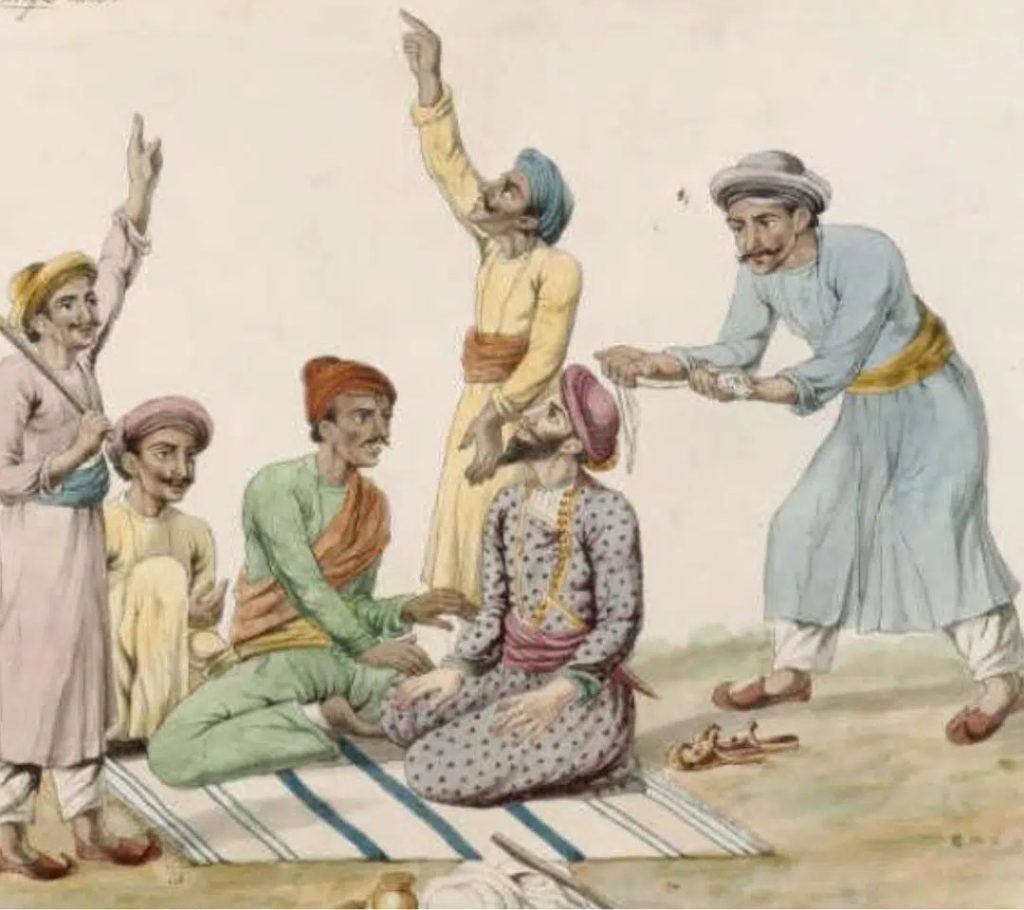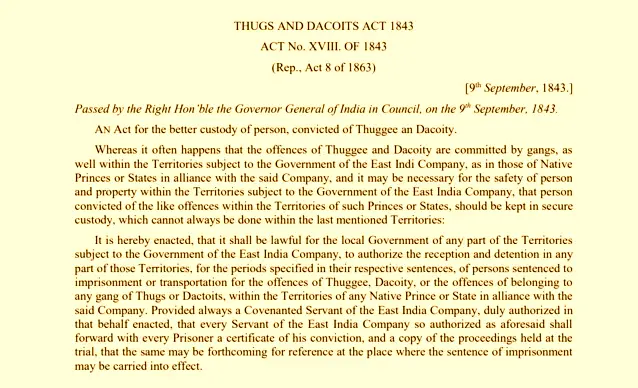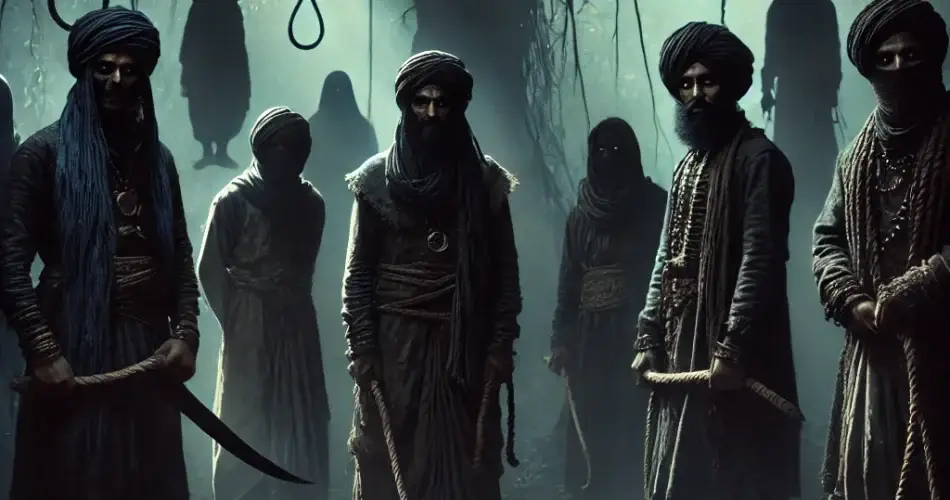The word “Thuggee” is from the Hindu language, and it is directly translated as “Deceiver” or “Swindler.”
Operating for centuries, these clandestine groups of robbers and murderers left a trail of terror across the Indian subcontinent. Often masquerading as ordinary travellers, the Thuggees would join unsuspecting caravans only to betray them in the dead of night. Their signature method of killing—a swift and silent strangulation with a silk cloth—earned them a reputation as some of the deadliest serial killers in history.
Origin of the Thugee Cult
The Thuggee were a quasi-religious organization that operated in India, Bengal and Tibet between the 13th and 19th centuries. The organization is said to have splinted from an ancient Islamic sect to devote themselves to Kali, the Hindu goddess of destruction and rebirth.
Originally, the Thuggee were known and recognized by local authorities as a legitimate religious organization. Although they operated as highway robbers, they paid taxes and were even reported to provide protection to pilgrims at the time. However, they slowly evolved into insidious killers who targeted all travellers, including pilgrims.
The establishment and propagation of the Thuggee cult were aided by the enormous military activities in the region and the use of mercenaries. These armed men were often unemployed outside of wars and were drawn to the activities of the Thuggee as they moved from one employer to another.
How did the Thuggee Cult Operate?

It is easy to take one look at the Thuggee Cult and classify them as a bunch of unorganized highway robbers looking for quick fortune. However, this simplistic viewpoint does not do justice to the enormity and complexity of the cult.
The Thugge cult functioned as a sophisticated organization with a codified mode of operation. They worked in gangs of three or more and often targeted travelling groups with smaller numbers. Each gang had a leader who coordinated the operation of the gang.
Thuggees typically targeted travellers, especially those who appeared wealthy or carried valuable goods. They would join unsuspecting groups of merchants or other travellers, earning their trust over days or even weeks, pretending to be merchants themselves. They carried a few blades to avoid suspicion and had their own codified language that they used to communicate during operations.
When the right opportunity came (usually at night), selected members of the group distracted their victims with elaborate stories and conversations while others approached them from behind to strangle them with a handkerchief or a noose. The Thugge are also recorded to use poison on their victims; these poisons (Often prepared from the Datura plant) caused drowsiness and made the strangulation process easier.
After the murder, the merchants were robbed, and their bodies were sometimes mutilated to hide evidence. It is believed that the Thuggee avoided killing women and children during their operations.
Membership in the Thuggee cult was majorly passed within families from fathers to sons. Sometimes, children of Thuggee victims are abducted, raised and trained as Thuggee. Also, unemployed men could learn and train to become thugs under a guru.
According to the I979 Guinness Book of World Records, by 1800, the Thuggee had murdered more than two million people.
Religious Fanatics or Serial Killers
Central to the activities of the Thuggee Cult were their religious beliefs. They were deeply devoted to the Hindu goddess Kali and performed rituals in honour of the Hindu goddess before every operation.
Kali is the Hindu goddess of death and rebirth, and according to records, the Thuggee believed that they were helping to maintain the balance between good and evil in this world. These radical beliefs provided a moral justification that helped them to carry out the murders without remorse.
Also, a large percentage (about 30%) of Thugs that were later captured were Muslims. Although these thugs maintained their monotheistic faith, they still acknowledged Kali as a spirit subordinate to Allah.
However, it must be noted that these radical and violent beliefs were unique to the Thuggee sect. Other devotees of Kali did not share these murderous beliefs.
British Crackdown on the Thuggee Cult

By the 19th century, the Thuggee had spread to all parts of the Indian sub-continent, making travel with proper protection impossible. As the British East Indian Company began to establish itself in the region, it identified the Thuggee cult as a threat to trade and commerce and moved swiftly to eliminate it.
The Crackdown on the Thuggee started around 1820 and lasted till 1850. It was spearheaded by Captain William Henry Sleeman, an officer in the British East India Company. Sleeman employed a network of informants, many of whom were former Thuggees who had been granted clemency in exchange for their cooperation. These informants helped the British officers identify and destroy key Thuggee hideouts and understand the inner workings of the Thuggee cult.
The Thuggee and Decoity Suppression Act was passed, and a corresponding Thuggee and Decoity department was established to investigate and prosecute Thuggee crimes. The Worship of Kali was banned, Kali temples were destroyed, and many priests were arrested and persecuted.
Sleeman’s relentless efforts yielded significant results. Hundreds of Thuggees were arrested, tried, and convicted. Many were executed, while others were sentenced to long prison terms. The British also focused on disrupting the social and logistical networks that sustained Thuggee operations. Villages that harboured or supported Thuggees faced severe reprisals, and rewards were offered for information leading to the capture of Thuggee leaders. By the 1850s, the Thuggee menace had been largely eradicated,
Notable Thuggees in history
Several Thuggees gained notoriety throughout history for their ruthless efficiency and high body counts.
Behram
Behram, who was popularly known as the “King of Thugs”, was active in central India between 1790 and 1840. He is believed to have strangled more than 931 people, and although only 125 murders were confirmed, he is cited as one of the most deadly serial killers in world history. He was captured in 1840 and was executed with his family, who were also part of the Thuggee cult.
Syed Amir Ali
Syed Amir Ali was a significant figure in India’s Thuggee network during the early 19th century. Amir Ali’s parents were strangled by Thuggees, and he was abducted and raised to become a Thuggee himself. He is reported to have strangled more than 700 people during his operations.
He was caught in around 1840 and offered clemency in exchange for his cooperation. Syed Amir Ali accepted and turned informant, providing detailed information about the Thuggee gangs’ inner workings, organizational structure, and operational tactics.
Feringhea
Feringhea was another notorious Thug who, after his capture, turned approver (informant) and played a crucial role in exposing the network of Thuggee operations to the British government.
Is the Thuggee Story a British Invention
In recent years, there have been some claims that everything we know about the history and practises of the Thuggee might have been fabricated by the British in an attempt to dehumanize indigenous Indians as “savages” and justify their occupation of the region.
There are several reasons for this argument. First, almost everything we know about the Thuggee cult today came during the British occupation of India. This is a little suspicious since the British government has been known to make up such ridiculous stories in some of their other colonies.
Another argument is that the members of the Thuggee cult were well-known among the locals; this was one of the reasons why it was very easy for the British government to catch and persecute them. They lived freely in villages and cities and might have even held important positions. Surely, if the cult was as insidious as it is portrayed, they would not be able to survive and thrive as long as they did.
Do you agree? Share your opinion in the comments.
